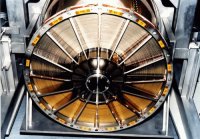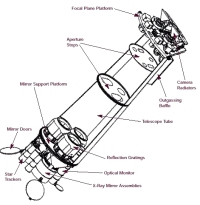Spacecraft
The spacecraft consists of several main sections:
- A nearly seven metre long black telescope tube
- A squarish service module, located at the spacecraft's forward broader end, also carrying the three 'mirror modules' and the deployable solar arrays
- The focal plane assembly housing the X-ray cameras and detectors at the spacecraft's other extremity.
This 'tri-clops', with its golden eyes is more than 10 metres long, just fitting under the Ariane 5 fairing for its launch. Its pair of solar panels has a 16-metre span.
 |
|
One of XMM-Newton's three golden eyes with its 58 wafer-thin mirrors |
The spacecraft's design features extremely high mechanical stability. Its position and control systems allow it to point at targets in the sky over long periods with a remarkable pointing accuracy of 0.25 arcsec over a ten second interval. In terrestrial terms, this is equivalent to using a hand-held telescope and seeing without any jitter a melon placed 180 km away!
Mirror modules
 |
|
XMM-Newton schematic |
Because of their high energy and their interaction with matter, X-rays are difficult to focus. When using mirrors, like XMM-Newton, the mirror surface has to be made of a material that does not readily absorb the X-rays, and the design has to ensure that the incoming rays hit the mirror surface at a shallow angle (grazing). Only in this way can the X-rays be efficiently reflected and directed to a focus point.
XMM-Newton uses barrel-shaped mirrors angled along their length to focus the X-rays on the detectors. The three 'mirror modules' each have 58 wafer-thin nickel mirrors, which are gold-plated and nested in each other just a few millimetres apart. The total mirror surface area of the three mirror modules together exceeds 120 m², rivalling the size of a tennis court. Constructing the mirror modules to such a level of perfection is one of the programme's greatest achievements.
XMM-Newton also carries the Optical Monitor, a 30-cm diameter telescope which observes the same region of the sky as the targeted X-ray sources, but at optical and ultraviolet wavelengths.
XMM-Newton's challenges
Realizing the XMM-Newton mission has been challenging in many respects. The space observatory was built in conditions of exceptional cleanliness to preserve its ultra-polished mirrors. Another requirement was light-tightness to prevent extraneous light entering the detector arrays.
The programme, with the parallel construction of two spacecraft models and the manufacture of the proto-flight model, was conducted in just under three years. Most of the testing was done on a modular basis, and the calibration of the mirror modules required intensive testing and calibration at different sites and facilities in Europe. The satellite was assembled in facilities of unusual dimensions.
